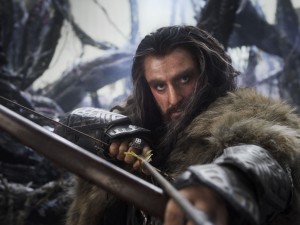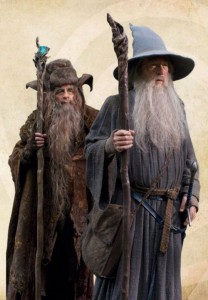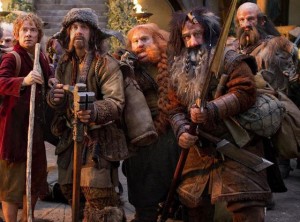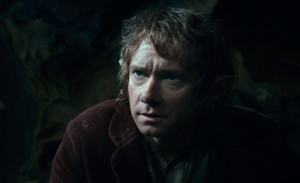
Another review from a staffer of TORN long ago, Wee Tanya brings her thoughts to you now.
Warning before you begin: Spoilers abound in this review. Read it or not, it’s up to you.
Tonight I had the extreme pleasure of watching a press screening of The Hobbit on behalf of TheOneRing.net. Not only was I ushered into the screening like an honored guest, but TheOneRing.net’s name is still renown, and I was even introduced by the night’s host to the whole crowd as “Wee from TORn”. Then he grilled me on Tolkien trivia, but don’t worry, I did us proud.
Much like Arathorn I’ve been keeping a low, spoiler-free profile for the past ten years. Life happened, and I managed to drift far enough away from the ride that when I caught up with Peter Jackson’s video diaries, I spent an entire evening watching every one. Fine, maybe I’m not totally unspoiled. But there I sat as the theater darkened, not knowing what to expect at all except for two things: first, that suddenly there were three movies instead of two; and second, that someone actually called the movie boring!
 I’d like you all to know that it was not boring, not a jot. The pace is beautiful, lyrical even, and in the middle of Rivendell it slows to the stately walk of Cate Blanchett’s Galadriel. But it might seem slow at first because there is a LOT of tale to tell. Bilbo begins even before “Concerning Hobbits,” back in the dark days of the Silmarillion, and establishes the sacking of Erebor and Dale before we even know what a Hobbit is! In my opinion this was necessary, because it opens up a wider world to stare at (in awe) before the camera pulls back to the familiarity of Bag End. I wanted the camera to pause at every detail of Erebor, because it was stunning. It echoes the designs of Moria from the first movies, but amplified, because it is a Dwarven city at the height of its glory instead of one abandoned.
I’d like you all to know that it was not boring, not a jot. The pace is beautiful, lyrical even, and in the middle of Rivendell it slows to the stately walk of Cate Blanchett’s Galadriel. But it might seem slow at first because there is a LOT of tale to tell. Bilbo begins even before “Concerning Hobbits,” back in the dark days of the Silmarillion, and establishes the sacking of Erebor and Dale before we even know what a Hobbit is! In my opinion this was necessary, because it opens up a wider world to stare at (in awe) before the camera pulls back to the familiarity of Bag End. I wanted the camera to pause at every detail of Erebor, because it was stunning. It echoes the designs of Moria from the first movies, but amplified, because it is a Dwarven city at the height of its glory instead of one abandoned.
I admit that my eyes started leaking the second I saw Bilbo put pen to paper, and I have to applaud the larger-story continuity of the first scene. It begins on the very same day as Fellowship of the Ring, and shows Bilbo writing in the Red Book, expanding upon his story (which we all know he finishes up in retirement in Rivendell, so it’s even more touching to see this flow). Ian Holm is the first Bilbo that we see, and he’s perfect, of course. Elijah Wood’s Frodo wanders through, giving the scene even more continuity as we see Bilbo watch him leave — little does Bilbo know, Frodo is off to his own adventure. And then Gandalf shows up, and after that come dwarves and more dwarves, and the story is up and running.
 But whose story? I’d like to posit that this movie is actually Gandalf’s story. Ian McKellen’s expressive eyes hold the heart of the plot, which for this movie boils down to, “Did Gandalf do well in choosing this particular burglar for the company?” McKellen must have some kind of meticulous timeline of Gandalf’s life in his head, because he can step back into the role of a younger, less secure, less shiny Gandalf with exquisite ease. Gandalf’s growth as a wizard is what’s tested here, and that stately-walking scene in Rivendel (which might be slow to some) is a fine moment in which we see Gandalf squirming in his seat, while his peers probe him: is this decision to help the dwarves really a good one? Can he back Radagast’s claim that the Necromancer is back, against the (slightly less Palantir-addled) Saruman? We’re not sure, and neither is he.
But whose story? I’d like to posit that this movie is actually Gandalf’s story. Ian McKellen’s expressive eyes hold the heart of the plot, which for this movie boils down to, “Did Gandalf do well in choosing this particular burglar for the company?” McKellen must have some kind of meticulous timeline of Gandalf’s life in his head, because he can step back into the role of a younger, less secure, less shiny Gandalf with exquisite ease. Gandalf’s growth as a wizard is what’s tested here, and that stately-walking scene in Rivendel (which might be slow to some) is a fine moment in which we see Gandalf squirming in his seat, while his peers probe him: is this decision to help the dwarves really a good one? Can he back Radagast’s claim that the Necromancer is back, against the (slightly less Palantir-addled) Saruman? We’re not sure, and neither is he.
 There are a few set pieces in this movie that all true fans expected, and all of them deliver. I was pleased to hear many songs meandering through Bilbo’s larder (That’s what Bilbo Baggins hates!), and while the cut was more like a fan’s extended version than Hollywood might want, in short: F*** ’em. Peter Jackson gave me the story that I would’ve bought and watched in an extended version anyway, and I’m overjoyed that a third movie gave him the space to spread out and tell the tale as it was told in the books. Did the set piece with the trolls feel the way it did in the book? Of course. And I even squinted at them to make sure they were in the same position that Frodo finds them in, in Fellowship of the Ring. (SEE, Peter Jackson? You knew we’d keep track.)
There are a few set pieces in this movie that all true fans expected, and all of them deliver. I was pleased to hear many songs meandering through Bilbo’s larder (That’s what Bilbo Baggins hates!), and while the cut was more like a fan’s extended version than Hollywood might want, in short: F*** ’em. Peter Jackson gave me the story that I would’ve bought and watched in an extended version anyway, and I’m overjoyed that a third movie gave him the space to spread out and tell the tale as it was told in the books. Did the set piece with the trolls feel the way it did in the book? Of course. And I even squinted at them to make sure they were in the same position that Frodo finds them in, in Fellowship of the Ring. (SEE, Peter Jackson? You knew we’d keep track.)
As for Smaug, we saw some beautifully filmed teasing, but the Big Bad (ok, Medium Bad; the Big Bad is the Necromancer) is being saved for the final film. In a nice visual paeon to a certain Dark Lord, the movie ends with a thinly-slit reptilian eye. Symbolism, I get it! Other beautiful moments for Tolkien fans abound. Watch for: That Moment when Bilbo stays his hand instead of slaying Gollum. Watch for: The intricately designed beauty of each and every domain, including the goblin kingdom above Gollum’s layer. Watch for: FIGWIT.
I won’t discuss Riddles in the Dark, because it’s perfectly done.
What did I dislike? Well. Radagast was saved from being cute by his Peter Jackson-grossness (is that BIRD POO ON HIS FACE? Oh God of course it is), his plot explicated neatly from the Silmarillion. Radagast was necessary for getting information about Mirkwood over to the rest of the world. It’s a fan’s retelling of how it happened, and I’ll pretend that Fran and Phillipa heard it from local lore, the kind of stories that might appear at the Prancing Pony.
In short, I loved this movie, and I want more. Two more. Fine, take my money, and show me as many movies as you want!


